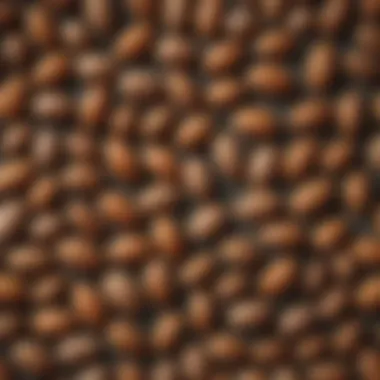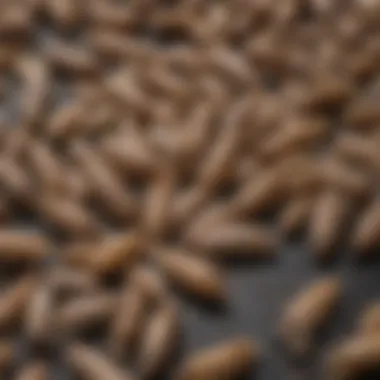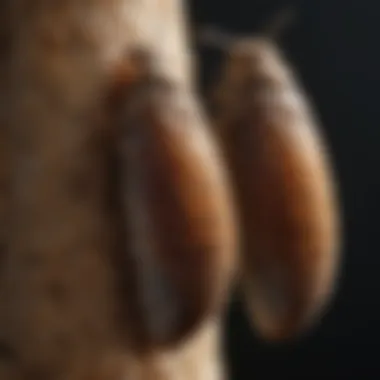Unveiling the Appearance of Pantry Moths: A Detailed Insight


Preventive Pest Control Strategies
When it comes to pest control, being proactive is key. Preventive measures can go a long way in keeping your home pest-free. Let's delve into some essential strategies to protect your household from unwanted intruders.
House Exterior Protection
Begin by inspecting your house exterior for potential entry points. Sealing any cracks or gaps in the walls or foundation can prevent pests from finding a way in. Clearing debris around the perimeter of your home also eliminates hiding spots for insects and rodents. By taking these simple steps, you can significantly reduce the risk of infestations.
Yard Maintenance
Your yard can be a haven for pests if left unchecked. Regular yard maintenance, such as mowing the lawn and trimming bushes, helps eliminate hiding spots for insects. Implementing methods like removing standing water and maintaining proper drainage can deter mosquitoes and other water-loving pests. Keeping your yard clean and well-maintained is crucial for overall pest control.
Indoor Cleanliness
Maintaining a clean indoor environment is crucial for pest prevention. Regularly vacuuming carpets, wiping down countertops, and storing food in airtight containers can limit food sources for pests. Expert cleaning tips include using natural ingredients like vinegar and baking soda to deter insects while creating an inhospitable environment for pests. By upkeeping cleanliness indoors, you create a less appealing habitat for unwanted guests.
Garbage Disposal
Proper garbage disposal is essential in controlling pest populations. Make sure to empty trash bins regularly and securely seal garbage bags before disposal. Rotting organic matter is a magnet for pests, so ensuring efficient waste disposal methods can significantly reduce the likelihood of infestations. Maintaining cleanliness in this aspect of household management is a critical component of pest control.
Other Pest Prevention Strategies
In addition to the aforementioned measures, consider innovative ways to safeguard your home against pests. This could involve using natural deterrents like essential oils, setting up barriers or traps, or investing in smart pest control devices. By implementing a combination of strategies tailored to your home's specific needs, you can fortify your defenses against unwelcome intruders.
Physical Characteristics of Pantry Moths
Understanding the physical characteristics of pantry moths is indispensable when attempting to identify and combat these pesky insects. By grasping the intricate details that define pantry moths visually, individuals can take proactive steps to prevent infestations and safeguard their pantry staples. From nuances in coloration to the morphology of these insects, each element plays a pivotal role in distinguishing pantry moths from other common pests.
Coloration
Pantry moths exhibit a range of color variations that aid in their camouflage and survival instinct within its surroundings. Understanding these colorations is fundamental in discerning these insects within household settings.
Light Brown
Characterized by a subtle hue that blends seamlessly with dry goods and grains, the light brown coloration of pantry moths serves as a protective adaptation. This color allows them to hide effectively in nooks and crannies of pantry shelves, making detection challenging for unsuspecting homeowners.


Reddish-Brown
The reddish-brown tint present in some pantry moths offers a slightly darker tone compared to light brown varieties. This coloration provides a genetic advantage in differentiating them from their predators, further increasing their chances of survival and proliferation.
Mottled Gray
The mottled gray coloration found in certain pantry moth species adds a touch of diversity to their visual appearance. This nuanced color pattern aids in their ability to blend with various surfaces and food items, making them elusive to the human eye.
Yellowish-Gold
Pantry moths with a yellowish-gold shade flaunt a unique aesthetic among their species. This vibrant coloration, although uncommon, plays a role in their visual appeal and may resonate with a select group of insects with distinct genetic predispositions.
Size and Shape
Measuring approximately half an inch in length, pantry moths boast a slender physique adorned with narrow wings featuring distinctive patterns. These physical attributes contribute significantly to their overall appearance and behavior.
Approximately / inch in length
The modest size of pantry moths, averaging half an inch in length, allows them to navigate easily through crevices and stored foods. This dimension enables them to access pantry goods discreetly, without drawing attention to their presence.
Slender, narrow wings
Equipped with slender and narrow wings, pantry moths possess flight capabilities that suit their erratic behavior. These wings provide them with the agility to maneuver swiftly in indoor environments, especially near light sources that attract them.
Distinctive wing patterns
The intricate patterns adorning the wings of pantry moths contribute to their visual allure. These markings serve as unique identifiers, distinguishing one species from another and acting as a key feature entomologists use to classify and study these fascinating creatures.
Antennae and Eyes
Pantry moths feature threadlike antennae and prominent compound eyes that play vital roles in their sensory perception and day-to-day activities.
Threadlike antennae
The threadlike structure of their antennae enhances pantry moths' ability to detect environmental cues and pheromones. This sensory adaptation aids in locating food sources and potential mating partners, contributing to their reproductive success and population growth.
Prominent compound eyes


Possessing prominent compound eyes, pantry moths exhibit keen vision that assists in navigation and predator detection. These eyes allow them to monitor their surroundings effectively and react swiftly to changes, ensuring their survival in dynamic and challenging environments.
Larvae Appearance
The larvae of pantry moths present distinct features like a white or off-white color, six legs, and a visibly segmented body. Understanding these characteristics offers valuable insights into the developmental stages and lifecycle of these insects.
White or off-white color
The larvae of pantry moths display a white or off-white coloration during their early stages of growth. This color variation aids in their concealment within food products and crevices, allowing them to feed and mature discreetly until reaching their pupal phase.
legs
Equipped with six legs, pantry moth larvae possess the appendages necessary for movement and food consumption. These legs facilitate their mobility within stored foods and assist in their burrowing activities, enabling them to access nutrition for growth and metamorphosis.
Visibly segmented body
With a visibly segmented body, pantry moth larvae exhibit distinct sections that represent different developmental stages. These segments highlight the larval progression towards adulthood, offering observers a glimpse into the intricate metamorphosis process that shapes these insects' life cycle.
Distinctive Features of Pantry Moths
As we delve into the intricate world of pantry moths, understanding their distinctive features becomes paramount. Recognizing these key characteristics not only aids in the identification process but also plays a pivotal role in formulating preventive strategies against possible infestations. The distinct flying patterns, feeding habits, and reproductive characteristics each offer unique insights into the behavior and lifecycle of these elusive insects.
Flying Patterns
Erratic flight behavior
One of the most intriguing aspects of pantry moths is their erratic flight behavior. This erratic and unpredictable movement pattern sets them apart from other household pests, making them challenging to catch or track. Despite their diminutive size, pantry moths exhibit remarkable agility in the air, darting swiftly from one location to another. This feature not only allows them to evade detection but also enables them to access various corners of the pantry or kitchen with ease.
Attraction to light sources
Another fascinating trait of pantry moths is their attraction to light sources. This behavior stems from their instinctual responses to natural light, leading them to gravitate towards artificial illumination within homes. While this may seem perplexing, understanding this attraction is crucial for implementing strategic trapping methods and deterring moths from congregating in specific areas. By leveraging their affinity for light sources, householders can devise effective control measures to combat potential infestations.
Feeding Habits
Feeding on stored food products


The feeding habits of pantry moths revolve around stored food products commonly found in households. These pests exhibit a voracious appetite for a wide array of items, including grains, cereals, nuts, and even pet food. By consuming these provisions, pantry moths not only compromise food supplies but also contaminate them with their excrement, posing health hazards to residents.
Creating webbing in infested areas
In addition to feeding on stored food products, pantry moths are known for creating webbing in infested areas. This intricate webbing serves multiple purposes for the insects, including shelter, egg-laying sites, and pathways for traversing infested locations. The presence of webbing signifies an advanced stage of infestation, prompting immediate intervention to mitigate the spread and eradicate the population.
Reproductive Characteristics
Egg-laying patterns
A fundamental aspect of pantry moth reproduction lies in their egg-laying patterns. Female pantry moths strategically deposit their eggs in secluded areas within the pantry or kitchen, ensuring the survival and proliferation of their offspring. By understanding these egg-laying tendencies, householders can pinpoint potential hotspots of infestation and disrupt the moths' reproductive cycle through targeted removal and sanitation practices.
Life cycle stages
Pantry moths undergo distinct life cycle stages, each crucial to their development and proliferation. From egg to larva, pupa, and adult moth, these insects experience metamorphosis throughout their lifecycle, adapting to different environmental conditions and dietary requirements. Recognizing these stages not only aids in identification but also informs effective control measures tailored to disrupt the life cycle and curtail future infestations.
Identifying Pantry Moths in Different Environments
In the realm of pest management, identifying the presence of pantry moths in various settings is akin to unlocking a cryptic puzzle. The ability to spot these minuscule intruders in diverse environments serves as a cornerstone in thwarting potential infestations before they spiral out of control. This section aims to shed light on the critical significance of recognizing pantry moths in distinct habitats, empowering homeowners with the knowledge essential for safeguarding their abodes from these clandestine nuisances.
Kitchen and Pantry Areas
In the intricate tapestry of a household, kitchens and pantries stand as prime sanctuaries for pantry moths seeking refuge. Delving into the lurking niches where these winged adversaries camouflage, understanding their tendencies becomes paramount. Unveiling the enigmatic realm of common hiding spots serves as a beacon of revelation for vigilant homeowners striving to preserve the sanctity of their culinary havens.
Common hiding spots
Navigating through the intricate shelves and crevices of pantries, pantry moths display a predilection for concealment amidst grains, flours, and dried fruits. Their adeptness at eluding detection in cardboard containers and cracks within pantry shelves renders them elusive foes. Shedding light on the subtle cues that hint at their presence within these abodes courageously equips homeowners in combating this voracious threat.
Signs of infestation
As silent infiltrators, pantry moths leave subtle signatures of their presence through tell-tale signs of infestation. From web-like strands clinging to packed food items to erratic flight patterns during nocturnal hours, these indicators serve as ominous warnings indicative of a looming infestation. Deciphering these cryptic messages acts as a preemptive strike in curbing the rampant proliferation of pantry moths within these vital spaces.
Storage Units and Cabinets
Beyond the confines of kitchen precincts, storage units and cabinets emerge as secondary hideouts where pantry moths orchestrate their insidious schemes. Exploring the favored breeding grounds and precautionary measures unique to these domains illuminates avenues for fortification against potential breaches in the household's defensive lines.
Preferred breeding grounds
Amidst the cradle of forgotten clutter and secluded depths of seldom-used cabinets, pantry moths choreograph their reproductive endeavors. Skilled in exploiting the dark recesses and minimal disturbances prevalent in storage units, these pests capitalize on the privacy afforded within these domains to propagate their burgeoning population. Recognizing these favored breeding grounds paves the way for preemptive interventions, curtailing their spread and preserving the integrity of stored provisions.
Precautionary measures
Incorporating robust defensive strategies concordant with best practices in pest management serves as a formidable shield against pantry moth incursions. From adopting a regimen of periodic cleaning and meticulous inspection of stored items to fortifying vulnerable entry points with airtight containers and sealing cracks in cabinets, these precautionary measures fortify the household's resilience against potential infestations. Empowering homeowners with these practical directives affords them the upper hand in preempting the incursion of pantry moths and upholding the pristine condition of their storage facilities.



